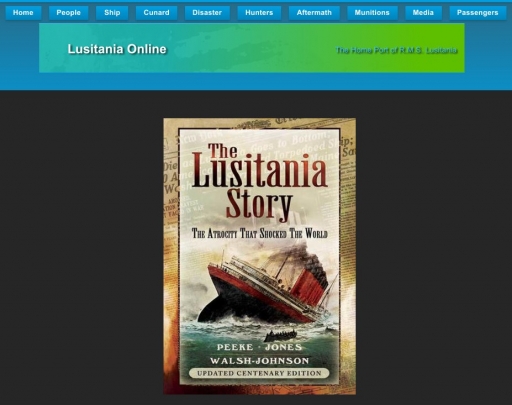Mitch Peeke has sent in the following comment article for Centenary News – which summarises his views on the sinking of the Lusitania. Mitch is a founder member of the Lusitania Online website.
Prior to World War One, the Lusitania and her sister ship, Mauretania, were the fastest passenger ships on the North Atlantic.They were the first ever quadruple screw Turbine powered steamers and they constantly vied with each other to hold the coveted Blue Riband for the fastest Atlantic crossing, a title Mauretania ultimately held till 1929.
But these two sisters had a secret. They’d been built with Government money and a condition of that was that in time of war, they would be requisitioned by the Royal Navy for use as Armed Merchant Cruisers.Ultimately, they didn’t have the range for such usage, but shortly after war was declared, Lusitania, in common with other British ships, was given a very important job to do.
By the beginning of 1915, it had become obvious that the war wasn’t going to be over by any forseeable Christmas. It was also obvious that the British Army in France was firing more shells per month than Britain’s armaments factories were making! Britain needed munitions urgently and turned to America.
The only way to get these US made munitions to Britain was across the Atlantic.A regular cargo ship took ten days to make the crossing and was highly likely to be targeted by German U Boats. The two Cunarders took half that time and outwardly were passenger ships. Henceforth, they and many other Liners such as those of the White Star Line, were used to transport munitions, as well as passengers. All had been going well, till Friday 7th May 1915. On that day, just 14 miles off the Southern Irish coast, Kapitan-Leutnant Walther Schwieger, commanding the German submarine U20, put a single torpedo into the starboard side of the inbound Lusitania. Two explosions followed and 18 minutes later the Lusitania was gone and the world was changed forever.
I became interested in Captain Turner’s story almost by accident. Back in 1998 I was planning a series of articles for the British Titanic Society’s journal. One of those was to compare Captain Smith of the White Star Line’s Titanic, with his nearest rival: Captain William Turner, Commodore Captain of the Cunard Line. The more I looked into Turner’s story, the more there was to find! I ended up not writing the articles but writing Turner’s biography, which was published in 2001 and went a long way toward clearing his name.
The second book, THE LUSITANIA STORY, almost wrote itself alongside Turner’s story. THE LUSITANIA STORY was published on both sides of the Atlantic over the Christmas/New Year period of 2002-2003 and has been highly successful as both a reference book and a general/maritime history title. It also examines why the British Authorities were SO keen to blame the Liner’s Master, Captain Turner, for the disaster, when it was clearly an act of war.
Thirteen years later, many other things have come to light about this most controversial disaster. The British Authorities have steadfastly denied that she was carrying munitions. Her original cargo manifest had been locked away, safe from prying eyes, ever since the ship sank.
In December of 2012, after 15 years of detective work, I finally tracked it down. It had been in President Roosevelt’s personal archive since January of 1940. After some final transatlantic negotiations, I obtained a certified copy and the necessary permissions to make this particular historical holy grail publicly available, via our website www.lusitania.net
In THE LUSITANIA STORY: The Atrocity That Shocked The World we updated the original 2002 published book,in time for the centenary of the disaster, including our further researches and findings. This newer version not only tells the complete story of this most famous Liner, it also closely examines why she was lost in a mere 18 minutes after being hit by just a single torpedo from a German U Boat, with the loss of 1,202 lives, on May 7th 1915
We have enjoyed the full and continued support of an American businessman, Gregg Bemis, who actually owns the wreck of the Liner. Gregg is also a Technical Diver and has spent years and a small fortune, surveying the wreck. Gregg has had some of the other, more populist theories about the second explosion, thoroughly tested in a top US Government laboratory. Among the theories that were literally tested to destruction were; coal dust, gun cotton, boiler and aluminium powder. Although each was spectacular in their own way, NONE of them proved to be anywhere near powerful enough to inflict the kind of damage needed to sink the 45,000 ton ship in a mere 18 minutes.
In 2008/9, Gregg’s explorations uncovered some of the THREE MILLION rifle bullets in her cargo hold. The bullets were just the tip of the iceberg and with his finds, our certified manifest and other evidence, we can now PROVE she was carrying munitions. We know that she was also carrying 5,000 LIVE artillery shells in her forward hold. Unfortunately for those aboard the ship that fateful day, a combination of ill-luck and a miscalculation on the part of U20‘s Captain; the one torpedo he fired hit the Liner in the ONLY place the underwater missile could render fatal damage to such a well found ship. U20‘s torpedo struck the ship ten feet below the waterline, directly behind her foremast.
Nine years after our book was first published, an independent specialist computer simulator was used in Germany which backed up our original findings as to where the torpedo had struck the ship. The torpedo had hit the forward cargo hold, right where the 1,248 crates of shells, four shells per crate, had been stacked and the mighty Lusitania‘s fate and the fates of 1,202 of the people aboard her, were sealed.
Copyright Mitch Peeke
